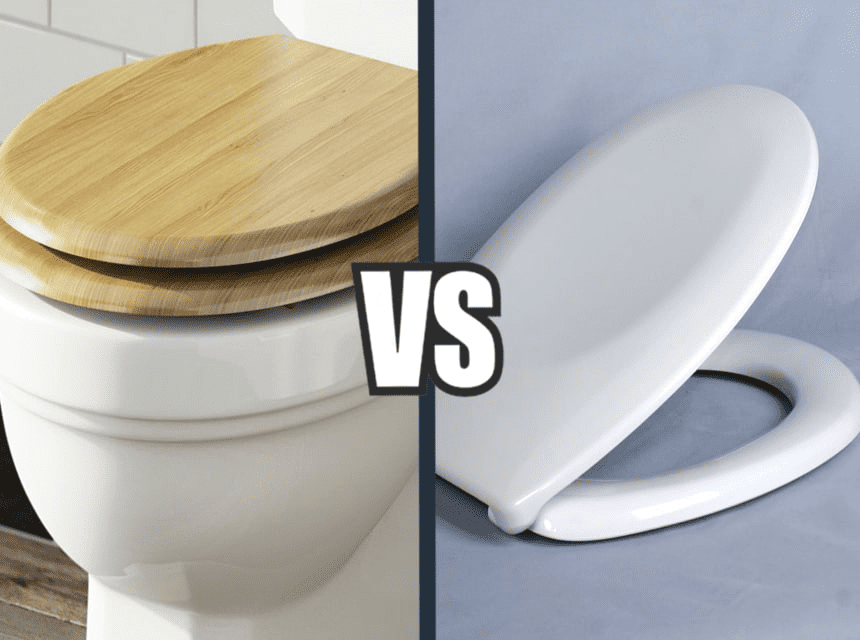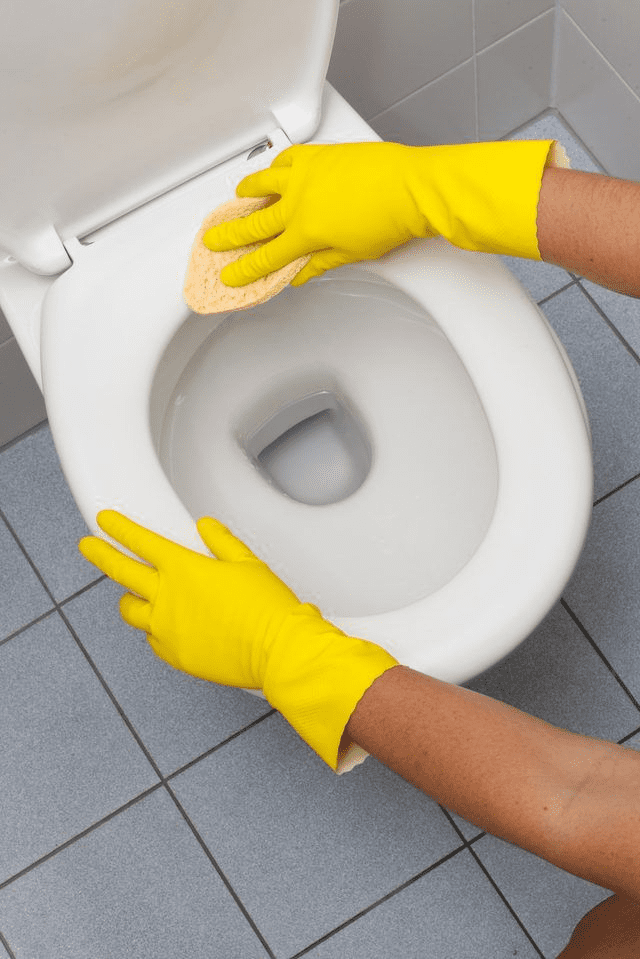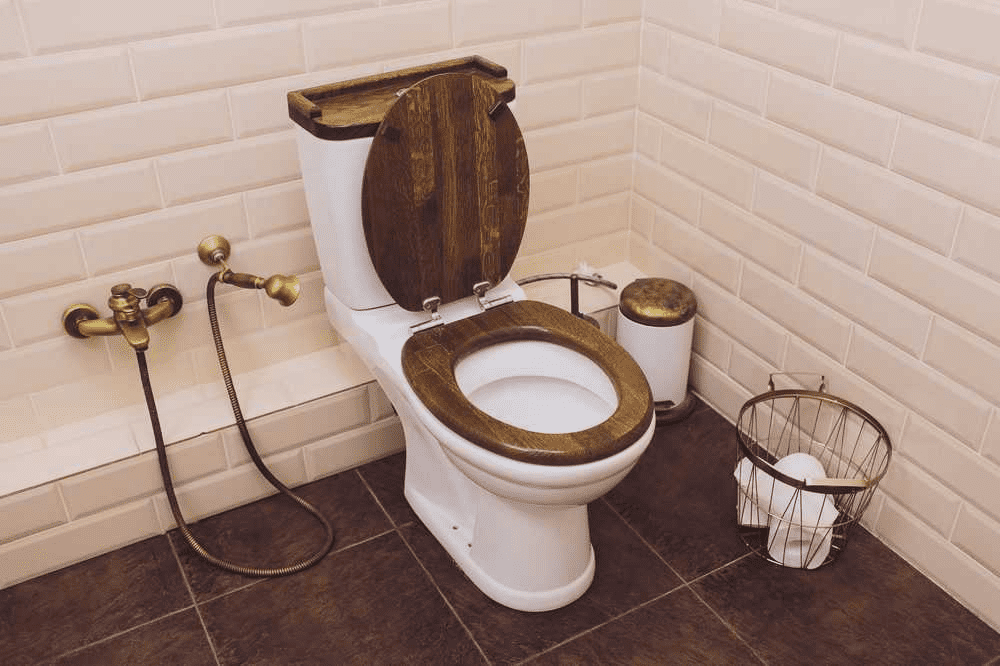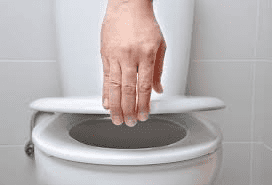You are about to renovate your bathroom, but looking at the old, stained toilet seat doesn’t match. Your toilet seat needs to be replaced. Now, what material is best for a toilet seat?
The latest research on Toilet Seat Market revealed that plastic dominates the market by being affordable and durable. Since the manufacturers have started using synthetic materials for making toilet seats, plastic has become one of the most popular choices.

However, wood isn’t far behind. Traditionally, before plastic, toilet seats were made out of wood. The popularity faded with plastic as a toilet seat material, but exotic wood is becoming popular by the day.
Therefore, after much contemplation, amongst all the materials, you have narrowed it down to the two best and most common toilet seat materials -plastic and wood. However, it remains unclear whether wooden or plastic toilet seats are better. However, the confusion still is plastic or wooden toilet seat? It is where we come in and solve this confusion.
To help you choose the best material for your toilet seat, in this article, we have compared plastic and wood toilet seats based on their durability, cost, versatility, cleanliness, and so on. Let us understand the basic overview of the differences before getting into the specifics.
Quick overview
| Plastic toilet seat | Wooden toilet seat | |
| Comfort | ✔ | ✔ |
| Warmth | ✘ | ✔ |
| Durability | ✔ | ✘ |
| Easy to clean and hygienic | ✔ | ✘ |
| Affordable | ✔ | ✔ |
| Soft closing | ✔ | ✘ |
| Heavy | ✘ | ✔ |
| Heat tolerance | ✘ | ✔ |
| Weight tolerance | ✘ | ✔ |
Plastic Toilet Seats -Explained
Did you know?
Most plastic toilet seats contain 50 percent recycled material. They are the products of other recycled materials. These recycled materials have been recycled several times before producing toilet seats.
As the name implies, plastic toilet seats are made of plastic. Thermoplastics and Thermoset are plastics used for making a plastic seat particularly. Though, a plastic resin is also a material option.
Regardless of the type of plastic, both have a high level of durability, which is essential since we use our toilets every day. Additionally, materials like these come in a variety of color shades and create many different designs, including soft-close plastic seats.
Concerning manufacturing, Thermoplastics or Polypropylene plastic can be heated and remolded several times, while Thermoset plastics or Duroplast can only be heated and molded once. Since thermoset plastic is more scratch-resistant than thermoplastic, it is more expensive.
Apart from being scratch-resistant, a plastic toilet seat offers a palette of colors that complement your bathroom decor. Furthermore, removing the plastic seat and cleaning is easy because of the plastic hinges, and some of them come in chromatic hinges as well.
However, the major setback plastic toilet seats have is cold. The plastic toilet seat often gets cold and uncomfortable, especially in the winters.
While a plastic toilet seat seems like a perfect toilet seat material, it does carry some benefits and drawbacks.
Merits
- Lightweight yet sturdy
- Highly durable and hard-wearing, if it is high-quality plastic
- Resilient to scratches, chips, or cracks
- Hygienic
- Easy to clean
- Affordable
Demerits
- The surface gets cold in winter
- Basic appearance
- Easily stained
- Less weight tolerance
- Less heat tolerance
Wooden Toilet Seat -Explained
Did you know?
Repeated use of a wooden toilet seat or prolonged contact with residue from harsh cleaning agents is harmful to the skin. It might irritate the delicate skin of children. Hence, the researchers suggest replacing wooden with plastic toilet seats to avoid toilet-seat dermatitis.
Firstly, you should know that there exist two types of wood –wood and enameled wood. Wood coated with enamel is enameled wood. The enamel coating gives the toilet seat a smooth surface and an impression of plastic.

Bamboo, oak, or wood veneer are types of wood frequently used for making toilet seats. Oak is one of the hardest wood, while bamboo is popular for its distinctive shape and color. On the other hand, veneer wood can blend blends with other wood creating a more cost-effective alternative for manufacturing a toilet seat.
Wooden toilet seats are made using either solid wood or molded wood. In terms of weight and thickness, solid wood toilet seats are heavy and thicker than molded wood.
Solid wood seats are easily recognized by their color as they retain their original color. The molded wood toilet seat, on the contrary, comes in different colors, much like plastic toilet seats.
The manufacturing process allows the wooden toilet seat to be sturdy and tolerate the heavyweight. Most importantly, unlike plastic toilet seats, wood has warmth and comfort. These wooden seats offer many benefits, but at the same time, it also carries some setbacks.
Merits
- Offers warm, inviting look to the bathroom
- Available in various finishes
- Warm and comfortable even in winters
- Higher weight tolerance
- Higher heat tolerance
Demerits
- More likely to rot overtime
- Less durable
- Retains moisture
- NOT so easy to clean and less hygienic
- No soft closing
7 Major Differences Between Plastic and Wooden Toilet Seats

source: bathroomer.org
Now, we have covered the basics of both materials. It is time to put plastic and wood to the test. We will discuss the wood vs plastic toilet seat based on factors important while choosing the right material for your toilet seat.
1. Comfort and Warmth
The only thing you touch with your bare bottom every day is a toilet seat. Wouldn’t you want it to be comfortable and warm enough? Of course, yes!
Tip -Ask yourself these two questions while getting a toilet: how comfortable is sitting on? And will it remain comfortable in all weather situations?
Both plastic and wood toilet seat is comfortable to use. However, it is a matter of your preference. Some folks love the feel of polished wood, while others the smooth finish of plastic.
According to the quality and manufacturing, wooden toilet seats are durable and solid. Plus, they don’t get cold and chilly like plastic. Instead, wood offers a warming and inviting look to your bathroom.
However, know that the warmth solely depends upon the temperature. Sometimes, based on the winters, wooden seats may or may not get cold but less.
Verdict -In terms of comfort and warmth, wooden toilets seats win over plastic.
2. Durability
There are different opinions about wooden and plastic toilet seats when it comes to durability.
Some say although wood seats are heavier and have greater compressive strength, they are susceptible to warping and cracking in excessive heat or humidity. As they are heavy, they are fitted with metal hinges to increase durability. On the other hand, plastic is not likely to be cracked or warped, but plastic hinges can be readily damaged and broken.
Others say, In comparison to plastic, the wood toilet seat survives longer. Since wooden toilet seats are heavy and sturdy, they are not likely to be broken like plastic. Although, remember that the finish of the wood determines its durability.
Verdict -Durability solely depends upon the quality and finish of the material. In this case, we cannot really say that because both the materials are durable in their own aspects.
3. Cleanliness and Hygiene
Cleanliness and hygiene are the most concerning factors while getting a toilet. Why? Because they are used every day and hence, need cleaning every day. It is a lot better to have items that are easy to clean and sanitary at the same time.
But, wood is a porous material that makes wooden toilet seats hard to clean. Often wooden seats are sealed or laminated. It prevents germs, grime, or stains from adhering to the toilet seat. Since wood has high porosity, it will retain moisture and rot over time.
On the flip side, plastic is non-porous, easier to clean, and hygienic than wood. Plus, it does not retain moisture. But, plastic toilet seats stain easily and are likely to show urine stains and other marks which need regular cleaning.
Verdict -At the end of the day, a plastic toilet seat offer ease cleaning and hygiene than wood toilet seat.

4. Appearance
When it comes to appearance, both of the materials are incomparable. It is because, in the end, it boils down to what you like and prefer.
As mentioned earlier, wooden toilet seats provide a comforting, warming, and inviting look. In addition, it blends well with rustic or traditional-style bathrooms.
And plastic offers a more premium, sleek finish to your bathroom. Hence, a plastic toilet seat often complements a modern, contemporary-style bathroom.
Verdict -Depending upon your preference, you can choose wooden or plastic toilet seats.
Bonus Tip -If you want a wooden toilet seat but desire a white, smooth finish. You can always opt for enameled wood toilet seats.

5. Soft Closing
While purchasing a toilet seat, the second thing we check after comfort is whether it is soft closing. Most toilets close quickly, making a loud, banging sound. The banging and quick close contribute to developing cracks and scratches on the toilet seat.
Hence, soft closing is a deciding factor while buying a toilet seat. Plastic toilet seats offer a soft closing feature. Besides, wooden toilet seats are heavy and would slam shut with a bang, making an annoyingly loud noise.
Verdict -Without a doubt, choose plastic toilet seats over wooden ones.
Did you know?
According to the government regulations, it is mandatory for all water closet seats to be open fronted or have an automated seat cover dispenser, except for those in dwelling units.

6. Life Expectancy
It isn’t surprising that wood is long-lasting because we use wood to build furniture that lasts a lifetime, whereas plastic is used to make throwaway items, meaning use & throw.
However, when it comes to toilet seats, they constantly suffer from heat, moisture, waste, etc. In this case, wood withstands the impact of everyday wear and tear but not for long. Unlike plastic, wood is more likely to rot and warp with time and use.
For example, if both the toilet seat are subjected to heat and corrosive liquid, a wood seat will become unusable sooner than plastic.
Verdict -Plastic toilet seat life expectancy is more than wood.
7. Cost
The last but not the least contrasting feature between plastic and wood toilet seat is cost.
The factors affecting the cost of the toilet seat are material, style, and brand. Generally, the price of a toilet seat ranges from $30 up to several hundred. On average, wooden seats are somewhat more expensive than plastic due to their wood type, manufacturing process, etc. Compared to that, a plastic toilet seat is inexpensive.
Calculate the cost of your toilet seat and its installation with the Toilet Seat Installation Calculator.
Verdict -We cannot really say wooden toilet seats are expensive, but they are slightly costly than plastic.
Conclusion
If you’ve been having trouble deciding between plastic and wood, taking into account the characteristics listed above might be a great help. Now, you have a lead, and based on factors like soft-closing, durability, life expectancy, you can decide.
Some may prefer plastic toilet seats for being durable, affordable, and easy to clean. Others may opt for wood toilet seats for comfort, warmth, and appearance. However, ultimately, it boils down to what you like and prefer.
![Granite Vs. Marble Vs. Quartz Countertops [12 Differences+Pros & Cons] Granite Vs. Marble Vs. Quartz Countertops [12 Differences+Pros & Cons]](https://houseadorable.com/wp-content/uploads/2022/03/quartz-marble.jpg)
![What Are Kitchen Sinks Made Of ? [13 Types+Pros & Cons] What Are Kitchen Sinks Made Of ? [13 Types+Pros & Cons]](https://houseadorable.com/wp-content/uploads/2022/01/Sink-MAterial.jpg)
![How to Disinfect Wood Cutting Board? [5 Methods] How to Disinfect Wood Cutting Board? [5 Methods]](https://houseadorable.com/wp-content/uploads/2023/01/1466451602030.jpeg)

![Wood Cutting Board Vs. Plastic Board [Which is Safer?] Wood Cutting Board Vs. Plastic Board [Which is Safer?]](https://houseadorable.com/wp-content/uploads/2023/01/wood-board.jpg)
![Ceramic vs Stainless Steel Sink [A Detailed Analysis] Ceramic vs Stainless Steel Sink [A Detailed Analysis]](https://houseadorable.com/wp-content/uploads/2021/12/Ceramic-vs-ss.jpg)
![Granite vs. Laminate Countertop [Pros and Cons+10 Key Differences] Granite vs. Laminate Countertop [Pros and Cons+10 Key Differences]](https://houseadorable.com/wp-content/uploads/2022/03/Granite-vs.-Laminate.jpg)
![Bamboo Vs. Wood Cutting Board [9 Differences Explained] Bamboo Vs. Wood Cutting Board [9 Differences Explained]](https://houseadorable.com/wp-content/uploads/2023/01/cutting-board.jpg)